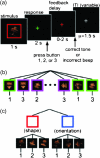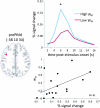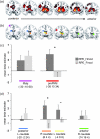Mechanisms of hierarchical reinforcement learning in cortico-striatal circuits 2: evidence from fMRI
- PMID: 21693491
- PMCID: PMC3278316
- DOI: 10.1093/cercor/bhr117
Mechanisms of hierarchical reinforcement learning in cortico-striatal circuits 2: evidence from fMRI
Abstract
The frontal lobes may be organized hierarchically such that more rostral frontal regions modulate cognitive control operations in caudal regions. In our companion paper (Frank MJ, Badre D. 2011. Mechanisms of hierarchical reinforcement learning in corticostriatal circuits I: computational analysis. 22:509-526), we provide novel neural circuit and algorithmic models of hierarchical cognitive control in cortico-striatal circuits. Here, we test key model predictions using functional magnetic resonance imaging (fMRI). Our neural circuit model proposes that contextual representations in rostral frontal cortex influence the striatal gating of contextual representations in caudal frontal cortex. Reinforcement learning operates at each level, such that the system adaptively learns to gate higher order contextual information into rostral regions. Our algorithmic Bayesian "mixture of experts" model captures the key computations of this neural model and provides trial-by-trial estimates of the learner's latent hypothesis states. In the present paper, we used these quantitative estimates to reanalyze fMRI data from a hierarchical reinforcement learning task reported in Badre D, Kayser AS, D'Esposito M. 2010. Frontal cortex and the discovery of abstract action rules. Neuron. 66:315--326. Results validate key predictions of the models and provide evidence for an individual cortico-striatal circuit for reinforcement learning of hierarchical structure at a specific level of policy abstraction. These findings are initially consistent with the proposal that hierarchical control in frontal cortex may emerge from interactions among nested cortico-striatal circuits at different levels of abstraction.
Figures





References
-
- Badre D. Cognitive control, hierarchy, and the rostro-caudal organization of the frontal lobes. Trends Cogn Sci. 2008;12:193–200. - PubMed
-
- Badre D, D'Esposito M. Functional magnetic resonance imaging evidence for a hierarchical organization of the prefrontal cortex. J Cogn Neurosci. 2007;19:2082–2099. - PubMed
Publication types
MeSH terms
Grants and funding
LinkOut - more resources
Full Text Sources
Medical
Research Materials

